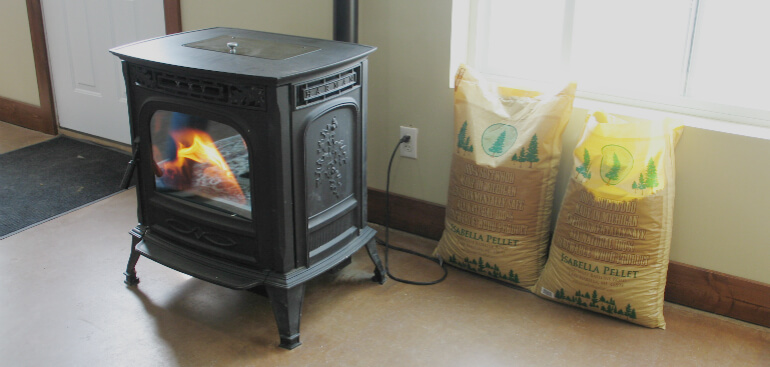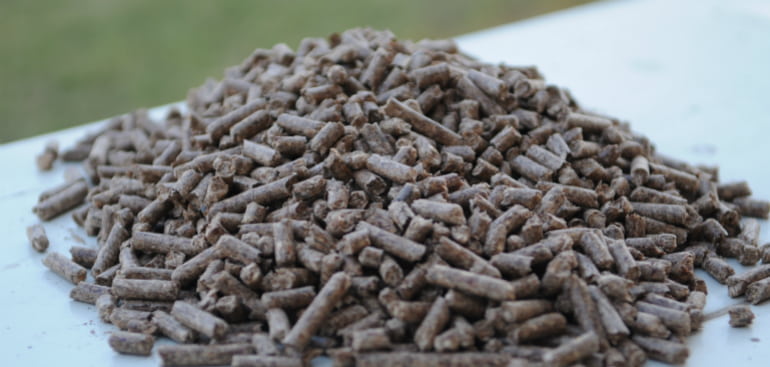Answer these simple questions and we will find you the BEST prices
Which type of solar quotes do you need?
It only takes 30 seconds
100% free with no obligation

Get up to 3 quotes by filling in only 1 quick form

Slash your energy bills by installing an energy efficient boiler

We’ve helped over 500,000 homeowners reduce their carbon footprint
- GreenMatch
- Boilers
- Biomass Boilers
- Wood Pellet Boilers
- Debunking the Myths About Wood Pellet Boilers
Debunking the Myths About Wood Pellet Boilers
What Are Wood Pellets Made of?
Wood pellets are small, tubular organic particles composed of compressed biomass matter. Pellets can be made from a wide range of resulting biomass waste products: industrial waste and co-products, food waste, agricultural residues, energy crops, sawdust and wood chips. Wood pellets are the most common type of pellet fuel that is currently available on the market and are usually made from sawdust and other related industrial by-products from the milling of lumber, wood products manufacturing and construction.
Wood pellet boilers can be applied commercially, but are used very commonly as domestic biomass boilers.
Busting the myths about Wood Pellet Boilers
When discussing the reasonability of using wood pellets as a heating source for biomass boilers, some of the arising questions are more common than others. There are many advantages of wood pellet boilers, but as it is always the case with relatively new products that enter the market, wood pellet and biomass boilers were not exempted from a number of misconceptions about the way these boilers should be used. Thus, we decided to select the 9 most popular wood pellets myths and reveal what is true and what is not about them.

"A handful of pellets is enough to operate a biomass boiler during the day, for heating a multi-store house."
Unlike nuclear fuel, wood pellets do not share similar energy capacities, to put it bluntly. Roughly speaking, it can be said that the calorific value of 1 kg of pellets is around 5 kWh, which might be sufficient to heat a 50 square metres room for one hour. Thus, in order to operate a wood pellet boiler throughout the day, one will have to use from 10 to 15 kilos of pellets, that is far from being a handful of pellets.

"Pellets burn better than ordinary wood logs. Hence, wood pellets might contain certain chemical additives in order to sustain the burning, and so do not represent the most environmentally friendly fuel."
Among the current solid fuels available on the market the wood pellets are one of the most eco-friendly. However, there are specific standards and guidelines (namely for the Swedish manufacturers of pellets) that allow for the use of chemical components for the purpose of glueing the wood residuals, most of the pellets producers do not add any binders or other burning improvement substances. The binding occurs under considerable pressure, namely due to the linking properties of the lignin the wood chips consist of. In addition to this, it should be mentioned that the better burning rates of the wood pellets are due to their high density and low humidity characteristics.


"Wood pellets can be stored anywhere for as long as one wishes."
There is no doubt about the fact that wood pellets can be stored for long periods of time, but whether one will be able to use them afterwards, is another question already. Wood pellets are quite susceptible to temperature changes, and like a sponge, can easily absorb a substantial amount of moisture. When stored outdoors for quite a while, the pellets will tend to absorb the moisture from the air, while stored in environments with frequent temperature changes (i.e. unheated garages) the pellets might soak up the moisture from walls and ceiling, places where condensation usually forms. Inappropriate storing of pellets will considerably decrease their calorific value, making them less efficient. Thus, it is important to make sure that the pellets are stored in a dry place, preferably indoors.

"The pellets folded in a pile will begin to smell bad and rot sooner or later."
Despite the fact that the pellets are made of wood processing by-products, the manufacturing process excludes the presence of mould or rot. Most probably, the occurrence of mold is caused by inappropriate storage conditions described in the lines above.

"White texture pellets are better than grey ones."
This might prove one of the most popular misconceptions about wood pellets. The pellets colour and smell have nothing to do with their quality. Finding out if you got a high or low-quality product, is possible only after burning the pellets. Nevertheless, when buying significant quantities of wood pellets, it is advisable to check the pellets’ glitter, if the pellets contain cracks, if the pellets do not crumble into dust if slightly rubbed, and if the length of these is not less than 7-8 mm.

"The pellets can also be used in a conventional boiler or stove."
The pellets will obviously burn in a conventional boiler or stove, which allows for the use of different heating fuels. Nonetheless, in a biomass boiler, the pellets burn at a constant and steady temperature that is maintained by controlled air injection into the combustion chamber, that makes the pellets burn at a moderate speed.
An ordinary oven would not deliver the same airflow adjustment capabilities as in a wood pellet boiler. Hence, if a significant amount of air is pushed into the oven, then the pellets will burn more rapidly and some of them will end up being dragged into the chimney due to natural air draft. In addition to this, the pellets’ small size will cause them to slip through the oven’s grate right into the ash drawer.


"There is no need to constantly clean the wood pellet boiler."
Even when using high-quality pellets made of solid wood (where the ash content constitutes no less than 0,5%), you’ll end up with around 5 kilogrammes of ash after burning a ton of wood pellets. Therefore, the boiler’s ash drawer will have to be cleaned periodically. The same rule applies to the boiler’s heat exchanger elements.

"The wood pellet boiler is difficult to adjust."
Depending on the boiler’s model, the only thing you’ll have to worry about is setting the coolant temperature, after which the boiler itself will adjust the required parameters, like the air volume and speed.

"The manufacturing of wood pellets might stop soon."
Even if it happens, then most probably it will be after the logging industry stops cutting trees. Still, given the number of recently built wood processing and wood-pellets production plants, as well as the pellets export potential, there are few indications that would hint to a possible halt of the pellets manufacturing in the near future.
Get Quotes on Boilers!
If you have decided to purchase a boiler, but you are not sure which type you would like, we are ready to help you. Fill out the form on this page with your personal preferences and information, and we will provide you with up to 3 different suppliers of boilers. You are free to choose the offer that best suits your needs. The service is free, without obligation, and takes only a few minutes.
- Quotes from local engineers
- Payment by finance available
- Save up to £975
It only takes 30 seconds



We strive to connect our customers with the right product and supplier. Would you like to be part of GreenMatch?




